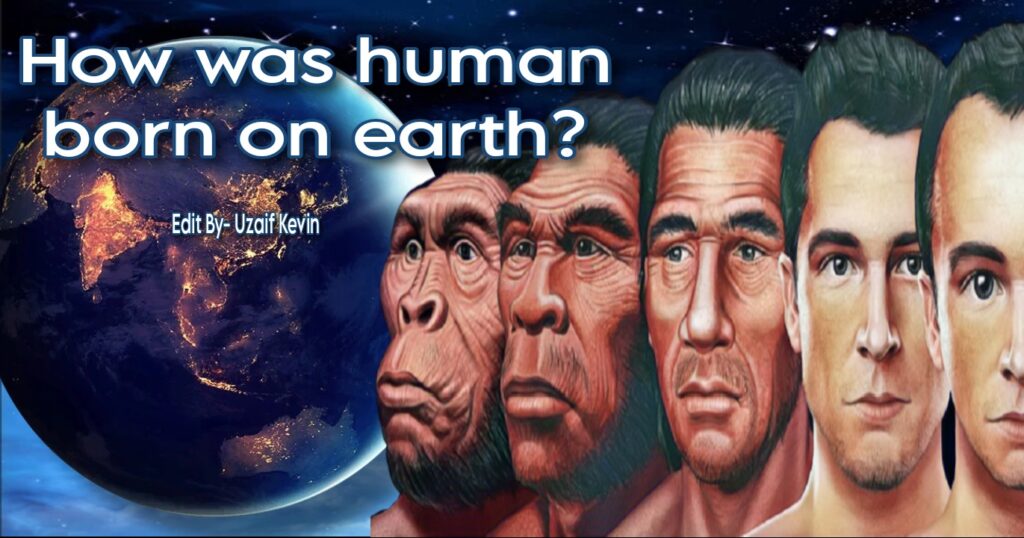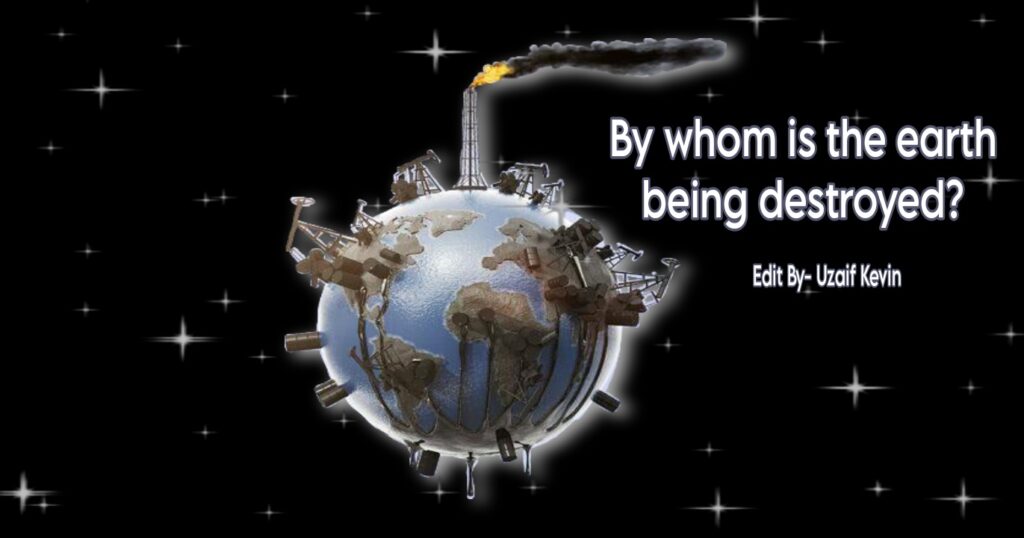Hello friends, I am Uzaif Kevin the author of your own website uzfkvn.com I hope you all are absolutely fine. I’m fine too. So without wasting time, in this Article I will tell you “How can we humans save the Earth? How was human born?”
First of all, know how our earth was formed? How humans survived so that you all understood everything correctly. So read the full article.
Soo Lets Begin,
Table of Contents
How was the earth formed?
The formation of Earth is believed to have occurred about 4.6 billion years ago through a process called accretion. Accretion is the gradual accumulation of matter due to gravity, which leads to the formation of larger and larger bodies.
The exact details of how Earth formed are still a subject of scientific research and debate, but the prevailing theory is called the nebular hypothesis.
According to the nebular hypothesis, the formation of Earth began with a giant molecular cloud of gas and dust in space, called a nebula.
This nebula underwent gravitational collapse, possibly triggered by a nearby supernova explosion or shockwave from a cosmic event. As the nebula collapsed, it started to spin and form a flat, rotating disk known as a protoplanetary disk.
Within this protoplanetary disk, material started to clump together due to gravity, forming small planetesimals. Over time, these planetesimals collided and merged, growing in size to become protoplanets.

These protoplanets continued to collide and accrete more material until one of them, which eventually became Earth, reached a critical mass and enough gravitational attraction to clear its orbit of debris, becoming a planet.
As Earth continued to evolve, it experienced intense heat and collisions, which caused it to differentiate into layers with a dense core, a mantle, and a crust. The core is believed to be composed mainly of iron and nickel, while the mantle is composed of solid rock, and the crust is the thin, outermost layer made up of solid rock and soil.
The process of Earth’s formation took millions of years and involved numerous complex interactions between gravity, heat, and materials in space.
The formation of Earth was a complex and dynamic process that unfolded over billions of years. After the protoplanetary disk formed, it continued to evolve, with smaller planetesimals constantly colliding and merging to form larger bodies.
These collisions generated tremendous heat and released energy, leading to the melting and differentiation of Earth’s interior.
During this early stage of Earth’s formation, the planet experienced intense bombardment by asteroids, comets, and other celestial bodies, known as the Late Heavy Bombardment.
These impacts caused widespread melting and cratering on Earth’s surface, and played a significant role in shaping the planet’s early geology and atmosphere.
As Earth’s core continued to grow, it generated a magnetic field through a process called dynamo action. This magnetic field helped to shield the planet from harmful solar radiation and cosmic rays, and played a crucial role in shaping Earth’s habitability.
Over time, Earth’s surface cooled, and water vapor in the atmosphere condensed, leading to the formation of oceans. These oceans, along with volcanic activity and other geological processes, gradually shaped Earth’s crust and atmosphere. Early life forms, such as simple bacteria, are believed to have emerged in these ancient oceans, paving the way for the development of more complex life forms over billions of years of evolution.
The formation of Earth was a fascinating and intricate process that involved a series of interconnected events, including accretion, differentiation, impacts, and the evolution of the atmosphere and oceans.
What is the earth made of?
The Earth is composed of various layers with different materials, which are collectively known as the Earth’s geology.
- Core: The Earth’s core is the innermost layer, and it is believed to be primarily composed of iron and nickel, with smaller amounts of other elements. The core is divided into two parts: the inner core, which is solid, and the outer core, which is liquid. The core is extremely hot, with temperatures reaching up to 9,932 degrees Fahrenheit (5,500 degrees Celsius) at the inner core.
- Mantle: The mantle is the layer above the core and makes up the largest portion of the Earth’s interior. It extends to a depth of about 1,800 miles (2,900 kilometers) and is primarily composed of solid rock, rich in iron, magnesium, and other elements. The mantle is responsible for the convective movements that drive tectonic plate motions and volcanic activity on the Earth’s surface.
- Crust: The crust is the outermost layer of the Earth and is the thin, solid shell that makes up the Earth’s surface. It is composed mainly of solid rock, such as granite and basalt, and is divided into several large tectonic plates that float on the semi-liquid asthenosphere of the mantle.
- Hydrosphere: The hydrosphere refers to all the water on Earth, including the water in oceans, seas, lakes, rivers, groundwater, and even water vapor in the atmosphere. Water makes up about 70% of the Earth’s surface and is a critical component for supporting life on the planet.
- Atmosphere: The atmosphere is the layer of gases that surrounds the Earth. It is composed mainly of nitrogen (about 78% by volume) and oxygen (about 21% by volume), with small amounts of other gases, such as carbon dioxide, water vapor, and trace gases. The atmosphere plays a crucial role in regulating the Earth’s climate and weather patterns.
These are the major components that make up the Earth’s composition. The Earth is a dynamic system with complex interactions between its different layers, and the study of its geology provides valuable insights into its history, structure, and processes that shape our planet.

How was human born on earth?
The origin of humanity, or the emergence of human beings, is a topic that has been studied by scientists and researchers from various disciplines, including anthropology, archaeology, genetics, and paleontology.
The exact details of how humans originated on Earth are still a subject of ongoing scientific research and debate, and our understanding of human origins continues to evolve as new evidence is discovered and analyzed.
However, the prevailing scientific theory supported by extensive evidence is the theory of evolution.
According to the theory of evolution, humans, like all other living beings on Earth, share a common ancestor with other primates.
Over millions of years, through a process of gradual biological changes driven by genetic mutations, natural selection, and other mechanisms of evolution, early hominins, which were a group of primates, gradually evolved into modern humans, known scientifically as Homo sapiens.
The process of human evolution is believed to have taken place over a span of several million years, with various species of hominins evolving and eventually going extinct, until the emergence of anatomically modern humans around 300,000 years ago.
These early humans, who had a similar skeletal structure and physical characteristics to modern humans, were hunter-gatherers who gradually developed the use of tools, language, and social behaviors.
How did humans survive to live on Earth in ancient times?
Ancient humans, like modern humans, had to adapt to their environment in order to survive and thrive on Earth. They developed various strategies and behaviors that enabled them to meet their basic needs for food, water, shelter, and protection from environmental hazards. Here are some key ways through which ancient humans were able to survive:
- Hunting and gathering: Ancient humans were primarily hunter-gatherers, relying on hunting animals for meat and gathering edible plants for sustenance. They developed tools and weapons, such as spears, bows and arrows, and stone knives, to hunt animals and gather food from the environment.
- Fire control: The ability to control and use fire was a significant development for ancient humans. Fire provided warmth, light, and a means for cooking food, which made it easier to obtain nutrition from various sources and also provided protection from predators.
- Shelter: Ancient humans built simple shelters using natural materials, such as caves, branches, leaves, and animal hides, to protect themselves from the elements and provide a safe place to rest and raise their families.
- Social cooperation: Early humans lived in social groups and worked together to meet their basic needs. Cooperation within groups allowed for the sharing of resources, division of labor, and mutual protection from dangers. Social bonds and communication were crucial for survival.
- Tool making: Ancient humans developed various tools for hunting, gathering, and processing food. Stone tools, such as handaxes, scrapers, and blades, were used for cutting, chopping, and processing plants and animals, which helped them obtain food and other resources.
- Adaptation to the environment: Ancient humans adapted to their local environment by developing specific knowledge and skills to survive in different climates, terrains, and ecosystems. This included knowledge about local plants, animals, water sources, weather patterns, and natural hazards.
- Cognitive abilities: Early humans had cognitive abilities, such as problem-solving, critical thinking, and innovation, which helped them navigate their environment, find food, and survive in changing conditions.
It is important to note that the strategies and behaviors of ancient humans evolved over time through trial and error, experimentation, and adaptation to changing conditions.
Their survival and success were dependent on their ability to adapt to their environment, learn from experience, and develop cultural practices that passed on knowledge and skills from one generation to the next.
These adaptations and innovations over time eventually led to the development of more complex societies and cultures, paving the way for the emergence of modern humans.

By whom is the earth being destroyed?
there are various human activities that have contributed to the degradation and destruction of the Earth’s natural environment over time. Some of the main factors that have been responsible for environmental destruction on Earth include:
- Human overpopulation: The world’s population has increased significantly over time, leading to increased demand for resources, habitat destruction, and pollution. The pressure of overpopulation has strained ecosystems and has contributed to deforestation, pollution of air and water, loss of biodiversity, and other environmental issues.
- Deforestation: Deforestation, or the clearing of forests for agriculture, logging, and other purposes, has resulted in the loss of habitat for many species, loss of carbon sequestration, disruption of water cycles, and increased greenhouse gas emissions, leading to climate change.
- Industrialization and pollution: The growth of industrial activities has resulted in pollution of air, water, and soil through emissions of toxic chemicals, pollutants, and waste. Industrial pollution has contributed to climate change, water pollution, soil degradation, and other environmental problems.
- Extractive activities: Extractive activities such as mining, oil drilling, and natural resource extraction have resulted in habitat destruction, pollution, and land degradation. These activities can have significant impacts on local ecosystems, biodiversity, and the livelihoods of local communities.
- Agricultural practices: Intensive agriculture, including the use of harmful pesticides, fertilizers, and monoculture practices, has led to soil degradation, water pollution, loss of biodiversity, and deforestation for expanding agricultural lands.
- Climate change: The burning of fossil fuels, deforestation, and other human activities have contributed to climate change by increasing greenhouse gas emissions, which have resulted in changes in temperature, precipitation patterns, sea level rise, and other environmental impacts.
- Consumerism and waste: Unsustainable consumption patterns, overconsumption of resources, and generation of waste have contributed to environmental degradation, including pollution, resource depletion, and habitat destruction.
Why is the earth getting so hot?
The Earth is getting hotter primarily due to human activities that release large amounts of greenhouse gases into the atmosphere.
The main greenhouse gases responsible for the warming of the Earth’s atmosphere are carbon dioxide (CO2), methane (CH4), nitrous oxide (N2O), and fluorinated gases.
These gases trap heat from the sun that would otherwise escape back into space, leading to an increase in global average temperatures, a phenomenon known as global warming.
The primary human activities that contribute to the increase in greenhouse gases and subsequent global warming include:
- Burning fossil fuels: The burning of fossil fuels such as coal, oil, and natural gas for energy production, transportation, and industrial processes releases significant amounts of carbon dioxide into the atmosphere. Carbon dioxide is the most abundant greenhouse gas and is a major contributor to global warming.
- Deforestation: Deforestation, or the clearing of forests for agricultural expansion, logging, and other purposes, releases carbon dioxide into the atmosphere as trees are cut down and burned. Forests act as carbon sinks, absorbing and storing carbon dioxide from the atmosphere, so deforestation reduces their capacity to sequester carbon.
- Agricultural practices: Agricultural activities, particularly intensive livestock farming, contribute to global warming through the release of methane, a potent greenhouse gas, from enteric fermentation in the digestive systems of livestock and from manure management.
- Industrial processes: Various industrial processes release greenhouse gases, such as carbon dioxide, methane, and fluorinated gases, during manufacturing, production, and waste disposal.
- Transportation: Emissions from vehicles powered by fossil fuels, such as cars, trucks, and planes, contribute to greenhouse gas emissions, particularly carbon dioxide and nitrogen oxide.
These human activities have significantly increased the concentration of greenhouse gases in the atmosphere, leading to an enhanced greenhouse effect and warming of the Earth’s surface.
As a result, global temperatures have been increasing over the past century and continue to rise at an alarming rate, leading to a wide range of impacts, including more frequent and severe heatwaves, extreme weather events, sea level rise, disruptions to ecosystems and agriculture, and other consequences on both local and global scales.

How can we humans save the Earth from Global Warming?
There are several ways we can contribute to saving the Earth from global warming and mitigating the impacts of climate change. Here are some key actions:
- Reduce greenhouse gas emissions: The most effective way to combat global warming is to reduce the emission of greenhouse gases into the atmosphere. This can be achieved by conserving energy, reducing the use of fossil fuels, transitioning to renewable energy sources such as solar, wind, and hydropower, improving energy efficiency in buildings, and adopting sustainable transportation options such as using public transport, carpooling, or using electric vehicles.
- Conserve resources: Efficiently using natural resources such as water, land, and materials can help reduce environmental degradation and greenhouse gas emissions. This includes conserving water, reducing waste, recycling, and practicing sustainable land management, such as protecting forests and promoting reforestation.
- Promote sustainable agriculture and food practices: Supporting sustainable agriculture practices, such as organic farming, agroforestry, and reducing food waste, can help reduce greenhouse gas emissions, promote biodiversity, and protect natural resources.
- Support policies and regulations: Advocating for and supporting policies and regulations that aim to reduce greenhouse gas emissions, promote renewable energy, and protect the environment can make a significant impact. This includes supporting initiatives such as carbon pricing, renewable energy incentives, and environmental conservation measures.
- Promote climate education and awareness: Educating oneself and others about climate change, its impacts, and solutions can help raise awareness and promote sustainable behaviors. This includes staying informed about the latest scientific research, sharing information, and engaging in discussions about climate change with others.
- Adopt sustainable lifestyle choices: Making conscious choices in our daily lives, such as reducing consumption, adopting a plant-based diet, conserving water, and minimizing waste, can contribute to reducing greenhouse gas emissions and mitigating climate change.
- Engage in collective action: Collaborating with others in communities, organizations, and advocacy groups to collectively address climate change can have a larger impact. This includes participating in climate activism, supporting environmental organizations, and engaging in local and global initiatives aimed at mitigating climate change.
Summary
At present there is no planet for us humans to live on, scientists are saying that we can live on Mars. But the atmosphere or environment which is of our Earth will not be found anywhere.
Will have to stay in capsule on Mars, will have to wear oxygen mask. It will be the same thing as if a patient is living his life through ICU or Ventilator machine.
Naturally, we have got the Earth where everything is present according to the survival of all the living things, so we do not value it.
By spoiling our own earth, we are asking people to live on Mars. Where you have to live like a patient.
I am the author of this blog Uzaif Kevin will tell you all that we all have to save our earth. How? Everything is explained in detail in this article.
More Read






